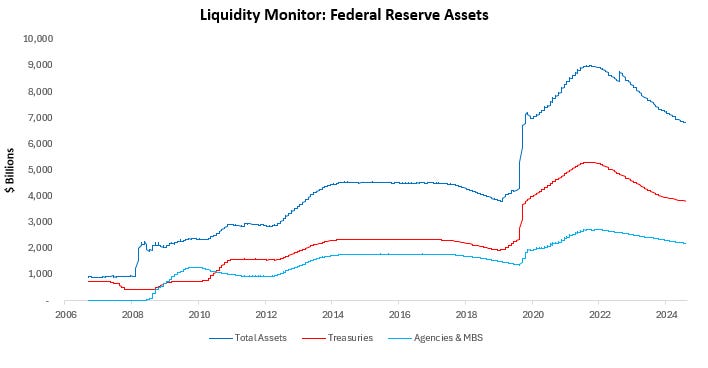We share our views on liquidity conditions. If you are unfamiliar with our approach to liquidity, we highly recommend reviewing our Macro Mechanics, where we outline our understanding:
What Is Liquidity?
14 October 2024
Turning to today’s note.
Our primary takeaways are as follows:
Liquidity conditions remain neutral.
Policy liquidity remains under pressure, driven by declining reserve balances. However, private sector liquidity is starting to see initial signs of recovery, with repo activity remaining stable and corporate issuance improving.
In the context of markets, neutral liquidity conditions are a support for risk assets. Consequently, our Asset Allocation strategy remains long commodities.
Liquidity is the flow of cash and cash-like assets that potentiate spending in the economy. Liquidity is determined by nominal dollar values and the relative risk profile of the various sources of liquidity. We begin our tracking of liquidity conditions by sharing the weighted growth rate of the major sources of liquidity: reserves, treasury bills, commercial paper, & repurchase agreements.
As we can see above, the current liquidity dynamics are primarily driven by repo conditions after being dominated by treasury bill issuance. Furthermore, conditions have been trending downwards and remain at the verge of a contraction.
We zoom on each of these components, starting with reserve balances. Reserve balances held by financial institutions at the Fed are a function of the gross liquidity supplied by the Fed through the asset side of their balance sheet relative to the gross liquidity absorbed by inflows into the liability side of their balance sheet. We visualize the asset side below:
The Fed continues to roll off its assets.
Additionally, we examine the changes in major liabilities of the Fed, i.e., the liquidity drain on the financial sector:
Nonetheless, while the treasury general account has decelerated, reverse repo has remained stable. This is additive for reserves, which is positive on liquidity.





